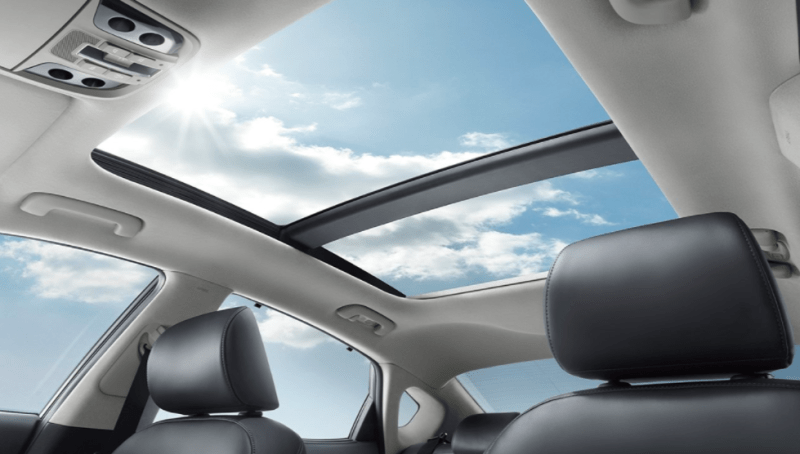The Sunroof is a movable panel, usually of glass, that is operable to uncover an opening in an automobile’s roof, allowing light and/or fresh air to enter the passenger compartment.
In older cars Sunroofs were manually operated however these days most units are electrically operated, and are available in many shapes, sizes, and styles. Today, most factory sliding sunroof options feature a glass panel and are often also marketed as Moonroofs.
Sunroofs are offered with most luxury cars and usually found in high-end trims of regular automobiles. Most automakers now offer are a new type of large or multi-panel called panoramic sunroof which offer openings above both the front and rear seats and may be operable or fixed glass panels.
Related: Car Spoilers: Style vs Purpose
However they are generally considered as an ‘accessory’ and the presence of sunroof in a vehicle purely depends on your personal preference. Though if you are not sure whether you should buy a car that comes equipped with a sunroof, we have sorted out the advantage & disadvantages of having them in your car.
Advantages:
- The first and most important one being the looks of the car! It gives the car a style of its own.
- Sunroof allows fresh air in the cabin when driving. It gives freedom and creates sort of a romantic ambience.
- If you plan to keep the windows open, there is so much noise from the gushing wind which makes it too noisy even to converse with fellow passengers. The sunroof is very good in such situations. The noise factor could be cut off and yet the car remains well ventilated with fresh air flow.
- When it’s drizzling, the view from your cabin with raindrops falling on the glass is immaculate.
- In areas where climate is usually cold, the sunroof during day time makes the cabin more illuminated & bright which gives you a pleasant feeling while driving.
Related: What Goes Wrong with Your Car and When?
Disadvantages:
- Usually when you buy a new car with Sunroof, you may try it out once or twice, but then about a week later you forget that it’s even there. The use particularly in cities with hot climate is minimal.
- Driving at high speeds with an open Sunroof affects the car’s aerodynamics as the laminar airflow becomes a turbulent top of additional drag.
- It’s a glass and can break. If it does then the replacement/ repairs are expensive.
- Sunroofs affect the mileage (fuel consumption) of a car according to a research. Regular sunroof assemblies weigh around 25-35 kg while the panoramic sunroof can weigh as much as 90kg.
- Sunroofs eat up headroom, since the sliding roof has to go someplace when it’s open. Cars with no sunroofs offer better headroom for their occupants.
- When your car gets old, the sunroof often starts to leak and that’s annoying. Not just because rainwater seeps in, but it will cause you trouble every time you wash your car at the service station.
- Keeping a sunroof in optimal working condition requires regular maintenance. The motors, electrical components, mechanical assemblies, rubbers, and glass itself requires a lot of attention.
- When your car gets old, rust usually occurs around the opening of roof (around the sunroof glass) which affects the structural integrity of the vehicle.
- Sunroofs works good and are trouble-free when the vehicle is new but as the car gets old, and you intend to sell it off, you may find your car hard to sell in used car market as old car buyers tend to turn away from hassles. It’s a mechanical complexity after all, and will wear out one day or the other.
So it all boils down to your preference, if you like it go for it. But if you don’t, there are good reasons to stay away from it! Given a chance to buy, will you buy a car equipped with sunroof? Let us know with your comments..

A computer animation professional with over 23 years of industry experience having served in leading organizations, TV channels & production facilities in Pakistan. An avid car enthusiast and petrolhead with an affection to deliver quality content to help shape opinions. Formerly written for PakWheels as well as major publications including Dawn. Founder of CarSpiritPK.com










